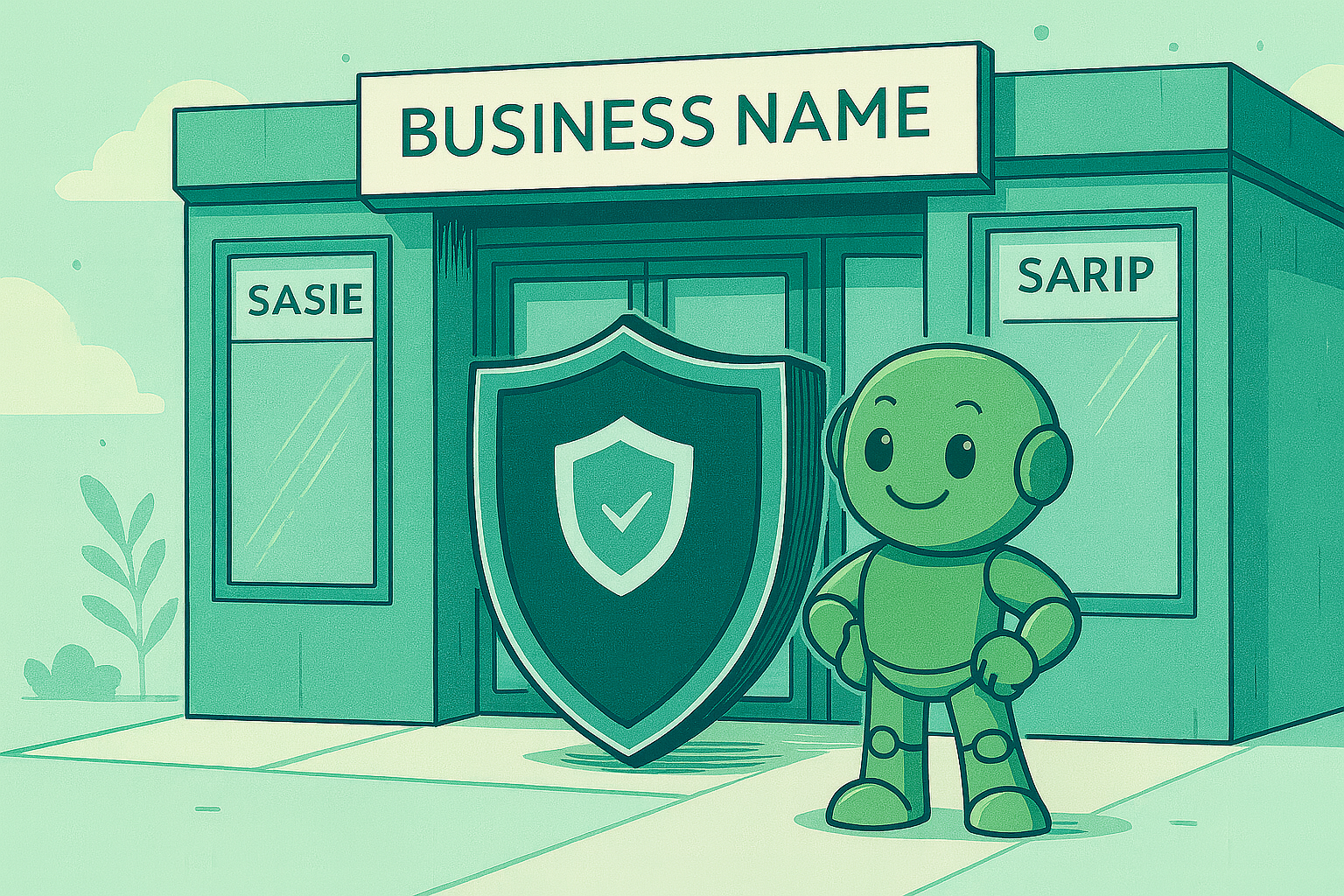Trademark a Business Name A Practical Guide
So, you're ready to trademark a business name. It's a huge step. This means going through a formal process with a government body, like the U.S. Patent and Trademark Office (USPTO), to lock in exclusive legal rights. Doing this turns your name from a simple business label into a powerful, protected asset. It's your legal shield against competitors trying to use a similar name and confuse your customers.
Why Trademarking Your Name Is a Business Imperative

I see this all the time: entrepreneurs assume that registering their LLC or filing a DBA ("Doing Business As") gives them the same rights as a trademark. This is a massive, and often expensive, mistake.
Let's be clear. A business registration is just an administrative handshake with your state. It stops someone else from registering the exact same name in that one state. That’s it. It offers almost zero brand protection, especially if you plan to operate online or expand.
A federal trademark, on the other hand, is the real deal. It grants you the exclusive right to use your name anywhere in the country for your specific goods or services. It’s the difference between renting an apartment and owning the entire building.
The Real-World Impact of Trademark Protection
Let's play out a common scenario. Say you start a fantastic local coffee shop in Austin, Texas, called 'Aura Beans'. You do the right thing and register your LLC. Around the same time, another savvy entrepreneur opens their own 'Aura Beans' in Seattle, Washington. Right now, both of you are legally in the clear.
The conflict sparks when one of you decides to grow. If the Seattle 'Aura Beans' launches a national e-commerce site, they could file for a federal trademark first. If they get it, they can legally block you from selling your coffee online under that name. You could be forced to rebrand your entire business, something I've unfortunately seen happen to good people.
Key Takeaway: A federal trademark transforms your business name from a local placeholder into a valuable, defensible asset. It’s a proactive strategy to secure your market position before a conflict arises, not after.
Securing your trademark early is the only way to avoid that nightmare. It puts the public on notice that you own the name, which naturally deters others from stepping on your toes. This protection is fundamental for building brand equity and earning customer trust.
The fight for brand identity is no joke. In 2023 alone, a staggering 15.2 million trademark applications were filed across the globe. U.S. companies currently hold around 3.5 million active registrations. These numbers tell a clear story: protecting your brand is no longer optional. If you want to explore more data on global branding trends, you'll see why trademarking is so critical.
Trademark vs Business Registration: What's The Difference?
It’s crucial to understand what each type of registration actually does for you. I've put together a simple table to break down the key differences in what they protect, where they protect it, and why.
| Protection Type | Geographic Scope | Purpose | Level of Protection |
|---|---|---|---|
| DBA/LLC Registration | State-Specific | Legal and tax administration at the state level. | Minimal: Only prevents identical name registration in your state. |
| Common Law Trademark | Limited to Geographic Area of Use | Established automatically by using your name in commerce. | Limited: Rights are confined to your immediate market area; difficult to enforce. |
| Federal Trademark | Nationwide | To protect brand identity and source of goods/services across the U.S. | Strong: Provides exclusive nationwide rights and a basis for legal action. |
Ultimately, choosing to trademark a business name is an investment in your brand's future. It lays the legal groundwork you need to grow your business, expand into new markets, and fiercely defend the unique identity you’ve worked so hard to build.
Conducting a Thorough Trademark Search Before You File
Before you spend a single dollar on an application, you absolutely have to do a deep dive search. I've seen it happen too many times: a founder falls in love with a name, builds a brand around it, and then gets the crushing news that it's already taken. It's a costly and demoralizing mistake that's entirely avoidable.
Think of this search as your pre-flight check. It’s a strategic business move that helps you spot obvious conflicts early, saving you a world of hurt and a lot of money. It's not just about getting your application approved; it's about building a defensible brand. To get a sense of how competitive this space has become, you can explore the full 2025 trademark filing report from Clarivate.
Start with a Knockout Search
First things first, you need to do what we call a "knockout search." The goal is simple: find any direct, dead-on conflicts that would immediately get your application thrown out. The good news? This is something you can, and should, do yourself.
Don’t just stick to one place. Your initial sweep should cover a few key areas:
- Google and other search engines: Run some broad searches for your proposed name. Look for companies in similar industries, even if they're in another state.
- Domain registrars: Is the .com version of your name already snagged? How about the .net or .co? A registered domain is often a sign of an existing business.
- Social media platforms: Check for your handle on all the big players—Instagram, X (formerly Twitter), Facebook, and LinkedIn. An active, branded profile is a huge indicator of prior use.
If you find a name that's identical or even just very similar being used for related goods or services, that’s a massive red flag. Honestly, it's often best to head back to the drawing board right then and there.
Key Takeaway: A knockout search is your first line of defense. If you find a direct conflict in the first 30 minutes of looking, you've just saved yourself months of wasted effort and hundreds of dollars in non-refundable application fees.
Dive into the USPTO TESS Database
Okay, so you've cleared the initial knockout search. Now it's time to get serious and dig into the official United States Patent and Trademark Office (USPTO) database, known as the Trademark Electronic Search System (TESS). This is the government's official record of all registered and pending trademarks.
Here's what you'll see on the initial USPTO search page:
The TESS system offers several ways to search, from a basic word mark search to more complex, structured queries for the pros.
Successfully navigating TESS isn't just about plugging in your exact name. The whole point is to look for a potential "likelihood of confusion," which is the number one reason the USPTO rejects applications.
You have to think like an examiner and search for variations:
- Phonetic Equivalents: Search for names that sound the same but have different spellings. If your name is "Kwik Fix," you must also search for "Quick Fix."
- Creative Spellings and Typos: Look for common misspellings or alternate versions. For a coffee brand named "Aura Beans," I'd also search for "Ora Beans."
- Related Goods or Services: A conflict can exist even if the names aren't identical, as long as the products or services are related. Let's say you want to trademark "Zenith Tech" for computer hardware. If there's already a trademark for "Zenith Software," you've got a likely conflict because customers could easily assume both come from the same company.
Know When to Call a Professional
Doing your own search is a fantastic and necessary start, but it has its limits. The TESS database won't show you "common law" trademarks—these are names that have gained legal rights simply through being used in commerce, even if they were never federally registered. These unregistered marks can still stop your application cold and even land you in legal hot water.
This is where hiring a trademark attorney or a specialized firm becomes worth its weight in gold. They have access to professional-grade search tools and, more importantly, the experience to conduct a truly comprehensive search that uncovers both registered marks and those pesky common law uses.
They can give you a clear legal opinion on your name's chances, providing you with the confidence to move forward or the straightforward advice to go back and pick a new name. It’s an investment in peace of mind.
Preparing and Filing Your USPTO Application
You've done the hard work of searching, and now it's time for the main event: preparing and filing your application with the U.S. Patent and Trademark Office (USPTO). This is where all your upfront diligence really pays off. Getting the details right at this stage is absolutely critical to avoid delays or, worse, a flat-out rejection.
This isn't just about filling out a form. It's about making a series of strategic decisions that will define your legal rights for years to come.
As you can see, filing involves carefully considering your mark, how you use it, and how you'll describe it to the government. Let’s break down what you’ll need.
Assembling Your Application Essentials
First things first, you need to gather your core information. This means the full legal name and address of the trademark owner. Is that you, as an individual, or your business entity like an LLC? Be precise here, as this establishes legal ownership from the get-go.
Next up is a big decision: the format of your mark. This choice has significant legal consequences.
-
Standard Character Mark: Think of this as protecting the name itself, no matter how it’s styled. If you trademark "Aura Beans" in standard characters, you have rights to that name whether it's written in a simple font or a fancy script. This offers the broadest protection for the words alone.
-
Stylized/Design Mark: This option protects a specific visual—your logo. It covers the unique font, colors, and any design elements that make up your brand's look. If your logo is a key part of how customers recognize you, this is the way to go. Many businesses I've worked with eventually file for both to lock down protection for the name and the logo.
Describing Your Goods and Services Precisely
Here’s where many DIY filers get tripped up. When you trademark a business name, you can't just say "clothing" or "consulting services." The USPTO demands a painstakingly specific description that fits into one or more of the 45 internationally recognized classes of goods and services.
An overly broad or vague description is a guaranteed ticket to receiving an Office Action—an official letter from the USPTO examiner demanding changes. For example, instead of "software," a much stronger description is "Downloadable software for use in customer relationship management (CRM) in International Class 009."
Pro Tip: Don't guess. Use the USPTO's free Trademark ID Manual. It's a searchable database of pre-approved descriptions. Using these official phrases dramatically increases the odds that your description will sail through the examination process without a hitch.
In-Use vs. Intent-to-Use: What's Your Status?
Your application must declare a "filing basis," which simply tells the USPTO whether you're already using the trademark or plan to soon.
Use in Commerce (Section 1(a) Filing) Choose this path if you are already selling products or offering services with your brand name across state lines (or internationally). You'll need to submit what’s called a "specimen," which is just real-world proof of your mark in action.
- For Goods: A photo of the name on product packaging or a label.
- For Services: A screenshot of your website or a marketing brochure where the services are actively offered under the mark.
Intent to Use (Section 1(b) Filing) If your business hasn't launched yet but you have a genuine plan to, this is your best bet. Filing an "Intent to Use" application lets you reserve your place in line and lock in your filing date. You won't need to provide a specimen right away, but you must eventually file a Statement of Use (and pay another fee) with a proper specimen once you start conducting business.
Choosing the Right Application Form
Finally, the USPTO provides two main online application forms via its Trademark Electronic Application System (TEAS): TEAS Plus and TEAS Standard. The one you choose affects both the cost and the rules you have to follow.
| Application Form | Filing Fee (per class) | Key Requirements |
|---|---|---|
| TEAS Plus | $250 | Lower cost. You must use a pre-approved description from the Trademark ID Manual and agree to all-electronic communication. |
| TEAS Standard | $350 | Higher cost. This form allows you to write a custom description, offering more flexibility for unique or niche offerings. |
For most entrepreneurs, the TEAS Plus form is the smartest choice. It's cheaper and streamlines the process. However, if you offer something truly specialized that just doesn't fit the ID Manual's descriptions, the flexibility of the TEAS Standard form is worth the extra cost. Picking the right form from day one helps put your application on the fast track to approval.
So You’ve Filed. What Happens Next? Navigating the USPTO Examination
Congratulations, you've submitted your application! That’s a huge step, but it’s important to understand this is the starting line, not the finish. You’re now entering the USPTO’s examination process—a journey that requires patience and a bit of strategy.
Once filed, your application joins a queue. It’s not uncommon to wait three to six months before it lands on the desk of a USPTO examining attorney. This person is your official point of contact, and their job is to determine if your business name legally qualifies for registration.
They will meticulously review every part of your application, from your description of goods and services to conducting their own search for conflicting marks. If they spot any issues, you won't get an outright rejection. Instead, you'll receive an official letter known as an Office Action.
Facing the Infamous Office Action
Don't panic when you see an Office Action. It’s not a final denial. Think of it as a formal request for clarification or a notice of legal problems that are blocking your registration. You’ll have six months to respond, and if you miss that deadline, your application is considered abandoned. It's a hard stop.
While the reasons for an Office Action can vary, most initial refusals boil down to two core issues:
- Likelihood of Confusion: This is the big one. The examiner believes your name is too similar to an existing registered trademark for related products or services, creating a risk that customers could be confused.
- Merely Descriptive: The examiner has decided your name just describes what you do or sell. Think "Creamy Ice Cream" for an ice cream parlor. Descriptive names are generally not granted exclusive rights on the Principal Register.
This is the moment where all your early research and due diligence really pay off. A well-argued response can overcome these refusals, but you need to present a solid legal case. For more on this, check out our guide to trademark clearance searches and brand protection tips.
Real-World Hurdles and How to Respond
Let's play this out with an example. Say you've applied to register "Evergreen Financial Planning." The examiner might issue an Office Action citing a "likelihood of confusion" with the already-registered "Evergreen Wealth Management." Your job would be to argue why consumers are sophisticated enough to tell the difference, perhaps by pointing to different service models or distinct client bases.
What if you applied for "Fast Delivery Service"? You're almost guaranteed to get a "merely descriptive" refusal. In that case, you might have to amend your application to the Supplemental Register (which offers fewer protections) or attempt to prove your name has gained "acquired distinctiveness" through years of extensive use and marketing—a very high bar to clear.
A strong response to an Office Action is a persuasive legal argument, not just a simple correction. It often requires citing previous cases, explaining the nuances of your market, and clearly demonstrating why your mark is entitled to registration.
The scale of this process is truly immense. With the global market for trademark services projected to reach $18 billion by 2025 and the USPTO handling over 250,000 examinations each year, it's clear how much scrutiny each application is under. You can discover more insights about these trademark law trends and statistics to see the bigger picture.
The Publication and Opposition Period
If the examiner is satisfied—either with your initial application or your response to an Office Action—your mark gets approved for publication. It will then appear in the Official Gazette, a weekly online journal from the USPTO.
This kicks off a critical 30-day opposition period. During this month-long window, any third party who feels they will be harmed by your trademark’s registration can file a formal opposition. This is most often a competitor who believes your mark treads too closely on their own brand identity.
If that 30-day clock runs out with no opposition, you've cleared the final hurdle. The USPTO will move forward and issue your official Certificate of Registration. Only then can you finally and officially add the coveted ® symbol to your business name.
Maintaining and Protecting Your Registered Trademark
Getting that trademark registration certificate in the mail feels like crossing the finish line. It's a huge accomplishment, but the reality is, your work isn't over—it's just entered a new phase. Owning a federal trademark isn't a "set it and forget it" deal. It's an active asset that needs ongoing attention to keep its legal power intact.
I like to think of a trademark registration like a deed to a house. You own the property, sure, but you still have to mow the lawn, pay your taxes, and watch out for squatters. Your trademark demands that same level of vigilance.
The Non-Negotiable Maintenance Filings
The U.S. Patent and Trademark Office (USPTO) needs proof you’re still actively using your trademark in business. These filings are not optional. If you miss a deadline, your registration will be cancelled, and all the protection you worked for will simply vanish.
Mark these dates on your calendar the moment you get your registration number:
-
Declaration of Use (Section 8): This is your first major check-in. It's due between the fifth and sixth years after your registration date. You'll need to file a sworn statement and provide a current "specimen"—a real-world example showing how you're using the mark today.
-
Combined Declaration & Renewal (Sections 8 & 9): This two-for-one filing is due between the ninth and tenth years post-registration. You'll again declare you're using the mark and also formally renew it for another decade. From here on out, you repeat this filing every ten years to keep the mark alive.
Falling behind on these filings is a costly mistake. While there is a six-month grace period, it comes with a hefty surcharge. It's much easier and cheaper to just get it done on time.
Your Duty to Police Your Trademark
Beyond the paperwork, you have a legal obligation to "police" your mark. This simply means you're responsible for keeping an eye on the marketplace to stop others from using a confusingly similar name. If you let infringements slide, a court could decide you've "abandoned" your rights, weakening or even nullifying your trademark.
Key Insight: The USPTO is not your brand's security guard. They grant the registration, but you are the one responsible for monitoring the market and enforcing your rights. Inaction can be seen as evidence that you no longer care about the mark as a unique identifier for your business.
So, how do you actually police your mark without it becoming a full-time job?
- Set Up Simple Alerts: The easiest first step is to create Google Alerts for your brand name and a few common misspellings. It’s free and will show you where your name is being mentioned online.
- Run Regular Searches: Every so often, take a few minutes to search for your name on social media platforms, in app stores, and across industry-specific websites. You're looking for anyone whose name is close enough to yours to cause customer confusion.
- Consider Professional Monitoring: For more comprehensive protection, you can hire a trademark monitoring service. These companies use software to automatically scan USPTO applications, new domain registrations, and other databases for potential conflicts, sending you alerts when they find something.
Using Trademark Symbols Correctly
Using the right symbol is a small detail that makes a big legal difference. It puts the public on notice that you are claiming rights to the name.
- ™ Symbol (for Trademarks): You can use the ™ symbol anytime you are claiming a name as your brand, even before you've filed an application with the USPTO. It signals your "common law" rights to the mark.
- ® Symbol (for Registered Trademarks): The ® symbol is reserved exclusively for marks that are officially registered with the USPTO. Using it before your registration is granted is a serious violation of federal law.
Consistently using the correct symbol reinforces your ownership and serves as powerful evidence if you ever find yourself in a legal dispute.
For a deeper dive into these post-registration strategies, our complete insider's guide to trademarking a business name covers everything you need to know. Protecting your brand is a marathon, not a sprint, but this ongoing commitment is what preserves the value and integrity of your business for years to come.
Answering Your Top Questions About Trademarking a Business Name
Even with a step-by-step guide, I find that entrepreneurs still have some very real-world questions about the trademarking process. Let's tackle the ones that come up most often in my experience, from what this will really cost you to how long you'll be waiting.
How Much Should I Actually Budget to Trademark a Name?
This is always the first question, and the honest answer is: it depends. Your total investment is a mix of required government fees and what you decide to spend on professional guidance.
The non-negotiable part is the USPTO application filing fee. Right now, that's either $250 or $350 for each class of goods or services you're claiming. If you're launching a brand that sells both physical products like t-shirts (Class 025) and offers online consulting (Class 035), you'll have to pay that fee for each one.
Bringing a trademark attorney on board is the other piece of the puzzle. While you can file on your own, hiring an expert is an investment in avoiding future headaches. A lawyer's fees for a thorough search and filing the application can run anywhere from $1,000 to $2,500, sometimes more if your case has unique complexities. It sounds like a lot, but it’s a fraction of what a legal fight over your name could cost you later.
The Takeaway: For a straightforward, single-class trademark you file yourself, you might get away with just the $250 filing fee. But for a serious business, a more realistic budget starts around $1,200 to have it managed professionally. I always advise clients to budget for professional help if they can.
What’s a Realistic Timeline from Filing to Registration?
Get ready to play the long game. The trademark process isn't quick, and it’s important to set your expectations. From the day you file to the moment you have that official registration certificate in hand, you're typically looking at 12 to 18 months—and that's if things go smoothly.
Here’s a rough sketch of how that time breaks down:
- The Initial Wait: After you submit your application, it sits in a queue. It will likely be 3 to 6 months before a USPTO examining attorney even opens your file for the first time.
- The Back-and-Forth: If the examiner finds any issues, they'll send you an "Office Action" letter. Responding and resolving these issues can easily add several more months to the clock.
- The Opposition Window: Once your mark is approved for publication, it's posted for a 30-day opposition period where anyone can object to your registration.
- The Final Stretch: If no one opposes your mark, it still takes the USPTO another 2 to 3 months to issue and mail your official registration certificate.
This long runway is precisely why filing an "Intent to Use" application is such a powerful strategy. It lets you lock in your place in line months, or even years, before you're fully launched.
What If Someone Is Already Using a Similar Name?
That moment of panic when you find another business with a name like yours is common, but don't assume your plans are dead in the water. The legal test isn't about whether the names are identical; it's about whether there's a "likelihood of confusion" for the consumer.
It really boils down to two critical questions:
- How similar are the names? Think about how they look, sound, and the impression they create. "Kwik Fix" and "Quick Fix" are a clear conflict because they sound the same.
- How related are the products or services? This is all about context. If one "Zenith" is a local bakery and another is an auto repair shop across the country, customers are unlikely to mix them up. No conflict there.
If the other company is in a totally different field and a different geographic market, you're probably fine. But if there's any overlap—if they're a direct competitor or even in an adjacent industry—you've got a significant hurdle. This is exactly the kind of situation where you shouldn't guess. A professional search and a legal opinion are essential when you want to trademark a business name, as making the wrong call can get your application rejected or land you in a lawsuit.
Ready to find a name that's not just creative, but also legally sound? The tools at NameRobot can help you brainstorm unique ideas and check their availability. From AI-powered name generators to instant trademark checks, we streamline the entire naming process. Start your naming journey with NameRobot today















